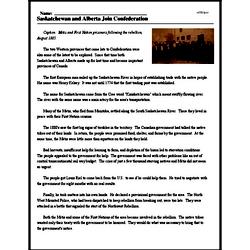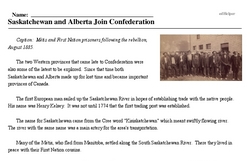Saskatchewan and Alberta Join Confederation
Caption: Métis and First Nation prisoners following the rebellion, August 1885.
The two Western provinces that came late to Confederation were also some of the latest to be explored. Since that time both Saskatchewan and Alberta made up for lost time and became important provinces of Canada.
The first European man sailed up the Saskatchewan River in hopes of establishing trade with the native people. His name was Henry Kelsey. It was not until 1774 that the first trading post was established.
The name for Saskatchewan came from the Cree word "Kisiskatchewan" which meant swiftly flowing river. The river with the same name was a main artery for the area's transportation.
Many of the Métis, who fled from Manitoba, settled along the South Saskatchewan River. There they lived in peace with their First Nation cousins.
The 1880's saw the first big signs of troubles in the territory. The Canadian government had talked the native tribes out of their lands. In return, the people were promised food, shelter, and farms by the government. At the same time, the Métis were little more than squatters on the lands they held.
Bad harvests, insufficient help for learning to farm, and depletion of the bison led to starvation conditions. The people appealed to the government for help. The government was faced with other problems like an out of control transcontinental rail way budget. The cries of just a few thousand starving natives and Métis did not seem so urgent.
The people got Louis Riel to come back from the U.S. to see if he could help them. He tried to negotiate with the government for eight months with no real results.




